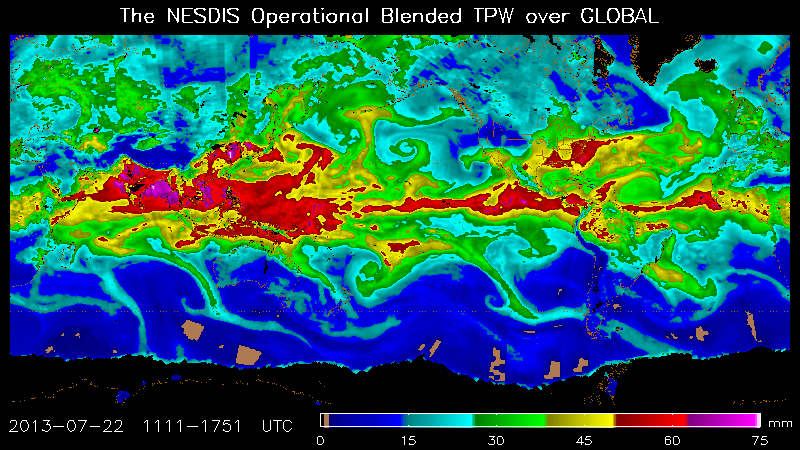Atmospheric Rivers
October 16, 2013 05:00 AM

Atmospheric Rivers
© Wenze Yang
by Wenze Yang, PhD., CICS-MD/ESSIC
Water vapor transport in the atmosphere, especially in the troposphere, is characterized by filamentary structure (see Figure), which could be thousands of kilometers long and, on average, only 400 km wide, hence the term “atmospheric rivers (AR)”. Atmospheric rivers have a central role in the global water cycle as they “are responsible for > 90% of all atmospheric water vapor transport in midlatitudes”, and are also identified as the major cause of extreme precipitation. In particular, when the flowing AR meet the mountains on the west coasts, including North America, Europe, and North Africa, there is typically prolonged, heavy rainfall and successive flooding. However, AR can be responsible for heavy rainfall events just about anywhere, as the moisture they provide help fuel precipitation forcings from slow moving weather systems.
Although AR are vital to atmospheric/hydrological research and applications, most previous identification work was done manually; only recently have there been attempts to develop an automated identification technique of AR. Wick et al. 2013 developed an Atmospheric River Detection Tool to address this problem, yet currently it performs only satisfactory in limited regions (e.g. northeastern Pacific Ocean) and is most useful when using model fields. Further work is needed to refine such a method to expand it for global use and to work with satellite derived fields of water vapor, which may have discontinuities (i.e., gaps between satellite swath, etc.)
Under a new CICS Task, Dr. Wenze Yang is working on developing a tool that can detect the atmospheric rivers automatically, correctly, and globally. This will allow us to carry out further AR-related research in a more systematical way. Ultimately, the goal is to build an AR climatology, so we can study how AR evolve with time, leading to more in-depth AR-related research.

Figure 1: Blended TPW from July 22, 2013

Figure 2: Automated AR Detection from July 22, 2013
SOURCES
Wick, G. A., P. J. Neiman, and F. M. Ralph, 2013, “Description and validation of an automated objective technique for identification and characterization of the integrated water vapor signature of atmospheric rivers”, IEEE Trans. Geosci. Remote Sens., vol. 51(4), pp. 2166-2176, doi:10.1109/TGRS.2012.2211024.
« Back